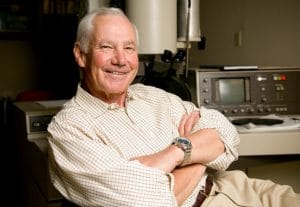As a boy, something caught Falkow’s attention. “Somehow I discovered the public library and happened on a book called ‘Microbe Hunters’ by Paul de Kruif,” he said, which “describes in colorful detail the microbe hunters Louis Pasteur, Robert Koch, Paul Ehrlich, Élie Metchnikoff, and others, who showed that microbes could cause disease.” The scientists in that 1926 book became his heroes, and he got a job at a toy store so he could get a start on his own microbe hunt: he traded his work time for a Gilbert Co. Hall of Science microscope. The first thing he looked at: bacteria in spoiled milk. And that was that — “At the age of 11, I decided to become a bacteriologist.” Labs were a good place for Falkow: he had a strong social anxiety — he even dropped out of school once due to panic attacks, but he went back and earned his Ph.D.

Falkow’s first breakthrough, in the 1960s, was showing that plasmids, a small DNA molecule in cells, can not only carry special traits, but they can pass those traits on to other cells. So what? This: that’s the mechanism that creates resistance to antibiotics. Worse, one type of bacteria could pass along these traits to other kinds of bacteria, so they become resistant to antibiotics too. Alarmed, Falkow testified before Congress about how dangerous it is to use antibiotics in animal feed, which helps the animals grow faster. He urged the non-medical use of antibiotics to be banned, but Congress refused to take action. “He was pissed off to the end” that his warnings were not heeded, said his wife, Dr. Lucy Tompkins — herself a professor of infectious diseases, microbiology, and immunology at Stanford University, where Falkow spent most of his career. Because Falkow knew microbes — perhaps better than anyone. “I never met a microbe I didn’t like,” he would often say, pointing out that it’s a mistake to think they all cause disease: there are 10 times as many microbes in the human body than human cells. We need bacteria to survive. But indeed there are negatives to them, too: his research helped uncover the molecular causes of a variety of diseases, infectious diarrhea, plague, food poisoning, whooping cough, ulcers, and even cat scratch fever.
While Falkow had controlled most of his social anxiety, he would still be nervous giving lectures. But that could have been worse. “He knew that he’d been nominated in the past for the Nobel Prize,” Tompkins said, “He’d tell me, ‘I absolutely don’t want it. It’s not who I am; it would change who I am. I’d be trotted out all over the place. I do not want it.’” However, he did accept the 2008 Lasker-Koshland Award for Special Achievement in Medical Science, and in 2015 the National Medal of Science, presented by President Barack Obama. But he was most proud of being elected in 2007 to the U.K.’s Royal Society. “It meant the world to him,” his wife said. “When he was asked to sign the book of members — the same book signed by Charles Darwin and Christopher Wren — he was so nervous he dropped the quill pen on the floor.” Dr. Falkow retired to emeritus status in 2006, but still went to Stanford nearly every day to teach, mentoring more than 100 students and postdoc researchers. In 2004, he was diagnosed with myelodysplastic syndrome, a type of blood cancer, and told he had about two years to live. He spent his remaining time ensuring his students were fully trained to continue work on microbes. Shortly before he died, he told Tompkins, “At least now I won’t get the Nobel Prize.” But he is considered to be the “father of the field of bacterial pathogenicity,” Stanford says. Dr. Falkow died May 5, from the complications of his disease, and several strokes. He was 84.
– – –
Author’s Note: If antibiotic resistance is not solved, the world is in pretty big trouble. Today, antibiotic-resistant infections kills 700,000 people each year worldwide. By 2050, that number is estimated to grow to 10,000,000 people per year, and is already considered “one of the biggest health threats that mankind faces.” (Source)
